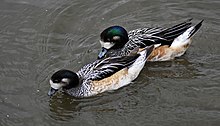Chiloé wigeon
| Chiloé wigeon | |
|---|---|

| |
| Male (rear) and female (front) | |
| Scientific classification | |
| Domain: | Eukaryota |
| Kingdom: | Animalia |
| Phylum: | Chordata |
| Class: | Aves |
| Order: | Anseriformes |
| Family: | Anatidae |
| Genus: | Mareca |
| Species: | M. sibilatrix
|
| Binomial name | |
| Mareca sibilatrix (Poeppig, 1829)
| |

| |
| Synonyms | |
|
Anas sibilatrix Poeppig, 1829 | |
The Chiloé wigeon (Mareca sibilatrix), also known as the southern wigeon, is one of three
Description

The Chiloé wigeon has a body length of 46 to 56 cm (18 to 22 in) and a wingspan of 75 to 86 cm (30 to 34 in). The wing length is about 25 cm (9.8 in) and the weight is approximately 800 g (28 oz).[2][3]
This bird has an
Sexual dimorphism is relatively subtle in this species of wigeon. Males are usually somewhat larger and heavier, and with somewhat brighter plumage and more strongly pronounced iridescence of the cap. Apart from these features, it can be difficult to distinguish the two sexes.[4] Juveniles resemble adult birds, but the rust coloring on the flanks is diminished or absent.
Distribution and habitat

This duck is indigenous to the southern part of South America, where it is found on freshwater lakes, marshes, shallow lagoons and slow flowing rivers. Vagrants have been observed in South Georgia, South Orkney and the South Shetland Islands.
It breeds primarily in Argentina, Uruguay, and Chile. The northern border of the breeding range is in Argentina at 36° S and Chile at 40° S. It also breeds sparingly in the Falkland Islands.[5] It migrates to southeastern Brazil for the winter.[6]
It was first introduced to Europe in 1870; it soon bred in zoos.
Because the Chiloé wigeon is widely distributed and has a large, stable wild population, it is categorized as
Ecology and behavior


The Chiloé wigeon displays a variety of behaviors depending on habitat. It is an omnivore, feeding predominantly on aquatic plants and grass, and occasionally coastal algae.[4]
This monogamous species breeds in the austral spring, between September and December. Pairs inhabit very small breeding territories, building their nests in grasses and under bushes. The female lays eight to ten white or cream-colored eggs. After a gestation period of approximately 24–25 days the ducklings are born. The father helps raise the ducklings; however, he leaves the family after the offspring molt.
Captive hybrids with the Philippine Duck (Anas luzonica) have been described.[7]
References
- ^ . Retrieved 12 November 2021.
- ISBN 978-0002192347.
- ISBN 978-1853686252.
- ^ ISBN 951-98947-0-5
- ^ Wood, p. 86
- ^ Clements J (2007) The Clements Checklist of the Birds of the World, Cornell University Press, Ithaca
- PMID 34938444.
Works cited
- Kolbe, Hartmut; The Ducks of the World, Ulmer Verlag 1999, ISBN 3-8001-7442-1
- Woods, A, Woods, R: Atlas of Breeding Birds of the Falkland Islands, Anthony Nelson, Shorpshire 1997, ISBN 0-904614-60-3
External links
- Anas sibilatrix videos, photos & sounds on the Internet Bird Collection
- Sea World

